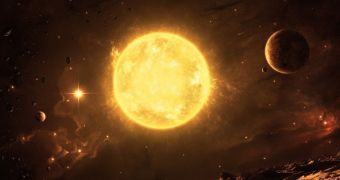A recent paper in the Astrophysical Journal Letters documents the discovery of two previously unknown stars, ULAS J0744+25 and ULAS J0015+01, that astronomers say are both cool red giants.
According to researcher John Bochanski, a visiting professor at Haverford College in the United States, what makes these stars stand out is the fact that they are the most distant celestial bodies of this kind thus far found in our galaxy.
More precisely, ULAS J0744+25 and ULAS J0015+01 are located at a distance of approximately 775,000 and 900,000 light-years from our planet, respectively, scientists detail in the Astrophysical Journal Letters.
“The distances to these two stars are almost too large to comprehend. To put it in perspective, when the light from ULAS J0015+01 left the star, our early human ancestors were just starting to make fires here on Earth,” says John Bochanski.
As detailed by Phys Org, this means that they sit about 50% farther from the Sun than any other of the stars that have until now been identified as being part and parcel of our home galaxy, the Milky Way.
What's more, they are about 5 times farther from our planet than the Large Magellanic Cloud, and the distance between them and Earth is the equivalent of a third of the one between our planet and the Andromeda Galaxy.
In their paper, astronomer John Bochanski and fellow researchers detail that these two newly discovered stars are located in the Milky Way galaxy's outer halo, whose makeup scientists are yet to fully make head and tail of.
Thus, despite advances made in the fields of science and space exploration, just 7 stars have until now been documented at distances of over 400,000 light-years from our planet. Needless to say, chances are many are waiting to be discovered.
Researcher John Bochanski and his team say that, when compared to the cool red dwarf stars that are closer to Earth, these two cool red giants are about 10,000 times brighter. It is because of this that their presence in our galaxy's outer halo did not go unnoticed.
Now that these two very distant stars have finally been put on the map of our galaxy, astronomers plan to further study them. It is expected that, in time, these cool red giants will provide information concerning how the Milky Way as we know it came into being.
“The properties of cool red giants in the halo thus preserve the formation history of our Milky Way. These stars are truly ghosts of galaxies past,” explains study co-author Beth Willman with Haverford College.
“It is remarkable to find stars this far out in the Milky Way galaxy. These results will undoubtedly shed new light on the formation and evolution of our galactic home,” adds specialist Daniel Evans.

 14 DAY TRIAL //
14 DAY TRIAL //